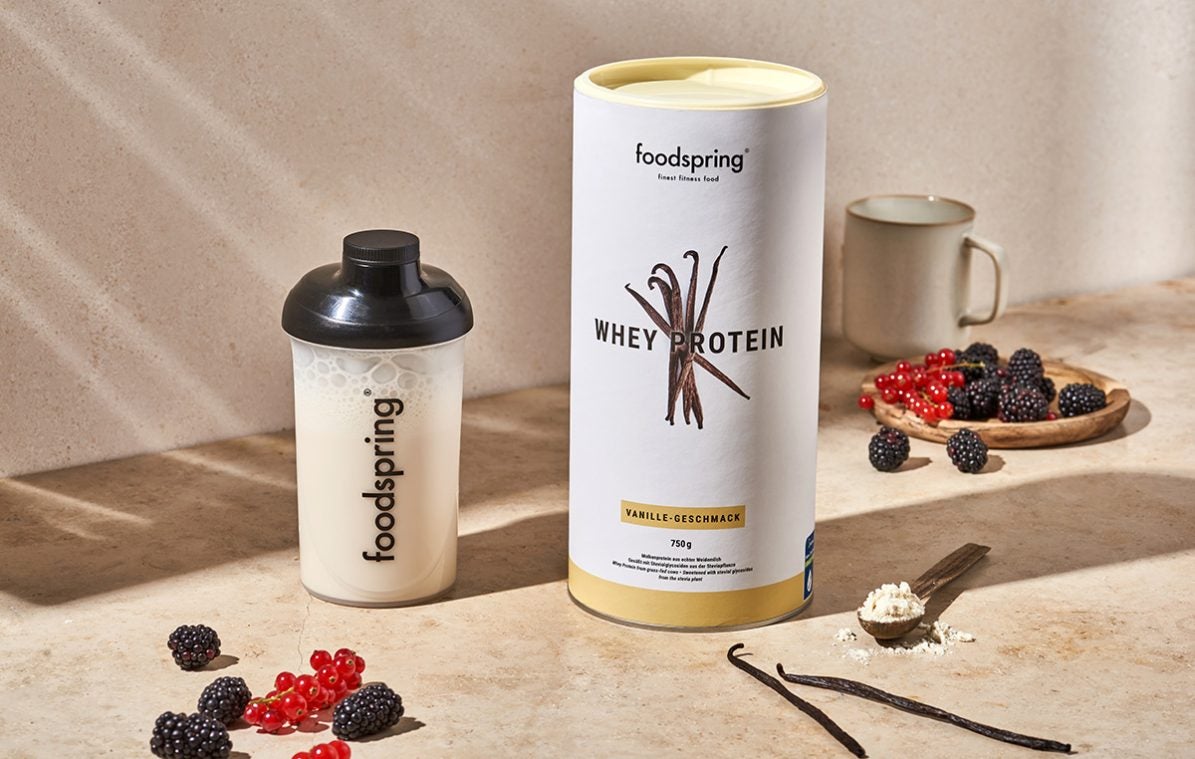An Athlete’s Guide to Whey and Plant Protein
 ©foodspring
©foodspring
We’ve come a long way from gulping down a big glass of egg whites after a weightlifting workout — though certainly there are plenty of builders who still swear by it. For most of us, the quickest way to get a big dose of muscle-building protein is to use a protein powder. We’ve got both a whey protein, plus a plant-based formula for the vegans out there. But how much to take, when to time it, and how can these powders get incorporated in a healthy lifestyle? We’ll tell you all.
Get your protein dosage right
Though whey protein powder is most frequently recommended for bodybuilding, you don’t have to be moving massive weights in order to enjoy its benefits. “Protein is found throughout the body—in muscle, bone, skin, hair, and virtually every other body part or tissue,” write the experts at Harvard T.H. Chan School for Public Health. “It makes up the enzymes that power many chemical reactions and the hemoglobin that carries oxygen in your blood. At least 10,000 different proteins make you what you are and keep you that way.”
The ideal amount of whey protein to consume will be the same no matter your goal, whether it’s muscle growth or weight loss. Aim to get about 20 to 25 grams of high-quality protein at any one time, but not much more. The body can only synthesize—use—so much protein at once, so more of the macronutrient won’t goose your muscle-building. Plus, consuming more than that in one shot simply won’t give you anything other than extra calories. Avoid eating more than 3g of protein per kg of weight to prevent unwanted stomach aches, bloating, and skin disorders. It’s also important to increase your fluid intake when you’re upping how often you’re getting protein, since your kidneys are working harder to break it down into usable forms.
The recommended daily allowance of protein varies from person to person because of factors like weight, height, and level of activity. You can calculate your minimum protein needs using this formula from the National Academy of Medicine: 0.8 grams of protein for every 1 kilogram of bodyweight, or 7 grams of protein, which translates to about 7 grams of protein for every 20 pounds of bodyweight.
Related: What else is your body craving? Learn more here!
What are good sources of protein?
Of course, all animal products are good sources of protein: meat, eggs, and dairy products. That said, you should look for high quality sources of animal protein. Look for humanely-raised, grass-fed meat, ideally from local producers. If you can, get to know the people from whom you buy animal products, so you know that the animals are well taken care of, and fed a diet that leads to the most nutritious meat, eggs, cheese, or dairy products for you. Because what the animal eats, you eat, too.
You don’t need to eat meat to get adequate protein. There are plenty of vegan sources, and some of them are complete, meaning they contain all nine essential amino acids. Think tofu, quinoa, seitan, and hemp. And if you eat a varied diet with different sources of vegan protein, combined they make complete proteins. And you don’t have to eat it all at the same meal. The body stores and uses amino acids as needed.
Of course, getting “doses” of protein throughout the day can be cumbersome. Because what are you supposed to do — pull a drumstick out of your briefcase on your way from one meeting to the next? Sure, you carry a cheese stick or some beef jerky, but the answer might be protein powder. Just throw the dry ingredient into a shaker bottle, then fill it with water when you’re ready for a high protein snack. You could even try some protein bites, or mix up a bowl of high-protein oatmeal.
How to fit protein powder into your workout goals
Fitness types are devoted to high-quality protein powder because the body quickly and easily absorbs it. People who are trying to gain strength or build muscle can consume 20 to 30 grams of whey or vegan protein in a shaker two to three times a day. But the best time to shake things up varies. Some make a protein shake in the morning, using it as an easy way to fuel up for the day, even if you don’t have a huge appetite. Others may like taking whey protein post workout, when a quick energy boost is exactly what their tired muscles need. You should try to have a helping of protein within 30 minutes of a workout to help replenish muscle stores.
And you can use protein powder as the basis of a nutrient-rich shake, too. Having powder in the presence of carbohydrates and fats may slow down the protein absorption, which may help the body better utilize the amino acids it contains, suggests a paper in the Journal of the International Society of Sports Nutrition. So be a shake chef. Add greens like spinach or collard greens, or even microgreens which are little nutritional powerhouses. Frozen berries add healthy carbohydrates and antioxidants. Add some vitamin and mineral packed mushroom powder, and some good fat from a source like ground flaxseed, which boasts omega-3 fatty acid. No need to stick with water, either. Milk, non dairy alternatives like soy or almond milk, and coconut water make for a great consistency. Speaking of which, if you like your beverage to have a milkshake-like feel, throw in some frozen, ripe banana chunks, or even steamed and chilled cauliflower. Talk about a nutritious meal!
How to choose a protein powder
Nowadays, there are plenty of protein powder options. How to choose? First, pick a brand you trust, because you don’t always know what’s in your canister. Researchers with the Clean Label Project, a nonprofit, screened 134 different protein powders for 130 different toxins. Some of the off-label “ingredients” they found? Arsenic, mercury, lead, and cadmium—and some of the products had significant levels of toxins. After you’ve identified a trustworthy brand, look for an option that has at least 75% protein and less than 5% sugar.
When you’re adding a new protein powder to your diet, start slowly. Sometimes supplements can disagree with people’s digestion. Have a small shake, and don’t drink it right before your workout. (Bad things can happen when you combine vigorous exercise and an upset gastrointestinal tract.) If all goes well, increase it incrementally in the following days. No one likes to slow roll their nutrition, but it’ll pay off in stronger muscles and more energy.
More healthy eating tips from foodspring:
Summer Meal Ideas to Stay Cool
14 Easy High-Protein Breakfast Ideas
12 foods for muscle building that you should always keep in your pantry
Sources for this article
We at foodspring use only high-quality sources, including peer-reviewed studies, to support the facts within our articles. Read our editorial policy to learn more about how we fact-check and keep our content accurate, reliable, and trustworthy.





























